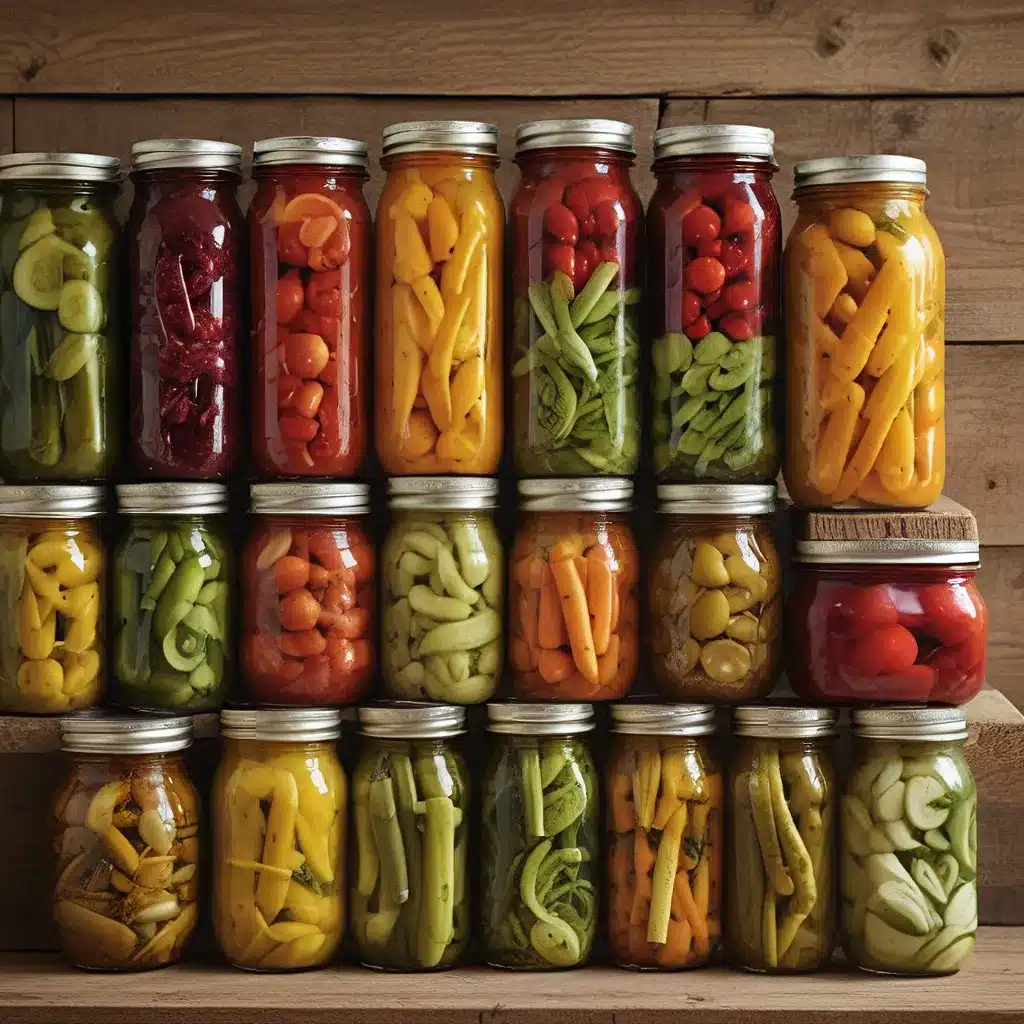
As the summer sun beats down and my garden overflows with ripe, juicy produce, I can’t help but feel a tinge of melancholy. Sure, I’ll enjoy all those fresh flavors for the next few weeks, but what happens when the seasons change and the harvest dwindles? Well, my friends, that’s where the magic of canning and pickling comes in!
Pickling Basics: Extending the Life of Your Harvest
Eating well year-round is a passion of mine, and pickling is one of my favorite techniques to make that happen. It’s like a secret superpower – I can take almost anything I grow and turn it into a delectable, long-lasting treat. From crisp cucumbers to tangy onions, pickling allows me to preserve the harvest and enjoy those flavors well into the winter months.
The key to successful pickling lies in understanding the science behind it. You see, most of the foods we love to pickle are naturally low in acid, which means they have a high pH. Now, here’s the tricky part: for pickling to work effectively and safely, we need to lower that pH to at least 4.6 or below. This is where the magic happens!
There are two main ways to add that all-important acidity: vinegar and fermentation. With vinegar-based pickles, I can rapidly infuse my jars with that tangy, preservative power. It’s like an instant pickle! But don’t be fooled – those quick pickles can sometimes have a slightly sharp flavor, and over time, they may start to lose their signature crispness.
On the other hand, fermented pickles take a bit more patience, but the end result is worth it. By using a salt brine to convert the natural bacteria in the produce into lactic acid, I can create a pickle that’s not only deliciously sour but also packed with probiotic benefits. The tradeoff? The fermentation process takes some time, and those jars need to stay nice and cool in the fridge.
Pickling lets you extend the life of almost everything you grow, whether you plan to eat it quickly or let the flavors develop over time. And the best part? You can customize the process to suit your personal tastes, experimenting with different spices, herbs, and even proteins to create a truly unique culinary experience.
Canning: Preserving the Harvest for Long-Term Storage
As much as I love the flexibility of pickling, sometimes I need a more long-term storage solution. That’s where canning comes into play. This tried-and-true preservation technique allows me to safely tuck away the fruits (and veggies!) of my labor, ensuring I can enjoy the flavors of summer well into the colder months.
What can I save through canning? The possibilities are practically endless! From juicy tomatoes and crisp green beans to sweet jams and tangy relishes, the canning process gives me the power to lock in freshness and flavor. And the best part? With a well-stocked pantry of home-canned goods, I can whip up delicious, nutritious meals all year round.
But canning isn’t just about the end result – it’s about the journey, too. There’s something incredibly satisfying about standing over a bubbling pot, carefully ladling hot, sterilized produce into jars, and watching as the lids pop shut, sealing in all that goodness. It’s a labor of love, for sure, but the payoff is oh-so-worth it.
Of course, like pickling, there’s a bit of science involved in canning. Maintaining the proper pH is crucial to ensure the safety and longevity of your canned goods. The magic number is pH 4.6 – any higher, and you run the risk of unwanted bacteria growth. That’s why it’s so important to follow tested recipes and techniques to the letter, especially when it comes to the all-important vinegar and water ratios.
Preserving the Harvest: A Culinary Adventure
As I look out at my overflowing garden, I can’t help but feel a sense of excitement. Sure, I could let all those fresh fruits and veggies go to waste, but where’s the fun in that? No, I’m going to embrace the preserve the harvest mentality and get to work pickling and canning my way to a year-round culinary adventure.
Will I encounter a few hiccups along the way? Probably. After all, every food has its own unique pH, which means I’ll need to adjust my recipes accordingly. And who knows – I might even discover a new favorite flavor combination that I never would have tried otherwise. But that’s all part of the fun, isn’t it?
So, if you’re like me and you can’t bear the thought of saying goodbye to summer’s bounty, I encourage you to dive headfirst into the world of canning and pickling. It’s a journey of exploration, experimentation, and, most importantly, delicious rewards. Who knows – with a little bit of patience and a whole lot of creativity, you might just transform your kitchen into a year-round flavor wonderland. Saint Marc has all the tools and ingredients you need to get started on your preserving adventure. What are you waiting for? Let’s get pickling!

